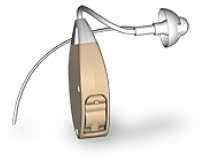Hearing Aids have been around for a long time and have always been designed to improve the hearing of people with some form of hearing loss.
Currently there are just two types of Aid, Analogue and Digital. The main difference is how the sounds that are received by the Aid are amplified and sent to the ear drum via the ear channel.
Analogue Hearing Aids work very simply in that the sounds received by a very small microphone in the Aid converting them into electrical pulses which are simply amplified before sending them to a speaker which converts the electrical impulses back into sound waves in a minute loudspeaker. This amplified sound is then transmitted down the ear channel to impact on the ear drum.
Digital Hearing Aids differ in one major part of this process. The sounds are still picked up by the microphone and converted into electrical impulses. These electrical impulses are now converted into `bits` of Data by a very minute computer chip inside the Hearing Aid. Each frequency is amplified separately and manipulated by a process called Digital Signal Processing.
The software has the ability to carry out precise changes to these `bits` of information before sending it to the minute loudspeaker to again be converted back into sound waves.
At first there doesn’t appear to be much difference in these Hearing Aids, they both collect sounds, amplifying them and send the amplified sound through the ear channel to the ear drum.
The major advantage of the Digital Hearing Aids is that it has the ability to be adjusted to vary the amplification at different frequencies. That is if the sufferer from hearing loss cannot hear high notes but can hear low notes then the Digital Aid can be adjusted to increase the high frequency sounds but not the lower frequency sounds, unlike an Analogue Aid which will amplify all the sounds equally.
As hearing loss is very different in the hearing impaired it is therefore extremely important to be able to adjust a Hearing Aid to the exact requirements of the sufferer. To find out the type of hearing loss a person may suffer from a hearing test is very important. This is usually carried out by an Audiologist who will ask you to respond to various sounds and frequencies over the full audio range.. As a result of this test it will easily be seen which areas the hearing is not as it should be. The Digital Aid can then be set up using a computer to compensate where there is some hearing loss and by how much.
Another ability of the Digital Aid is to adjust the Aid to reduce the sounds of very loud noises whilst still keeping other sounds at the required level. One of the biggest advantages is that background noise can be greatly reduced; this has a big advantage when talking to someone in a crowded room.
Although Digital Aids can give greatly improved hearing specifically adjusted to an individuals needs, it can never give a person back their normal hearing.
To find out more about hearing loss visit www.aids2hearing.co.uk
Subscribe to:
Post Comments (Atom)

Thanks for sharing the information regarding digital hearing aids. Basically the functioning of digital hearing aids is similar to the analog versions.The digital noise reduction feature in digital hearing aid is able to reduce noise gain that comes in the form of low frequencies.
ReplyDeleteDigital Hearing Aids
Certainly these days digital hearing aids have become much more advanced. They give you better feedback and speech enhancement. But before you buy a digital hearing aid, it is a must that you first consult and be examined by a medical ear specialist. Like eyes, your ears have also grade classifications, wherein the digital hearing aid must be adopted. Even a best digital hearing aid will not work for you right, if it is not fitted to your hearing requirement.
ReplyDeleteRegards,
Hearing Aid